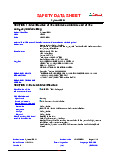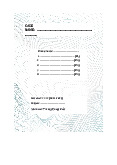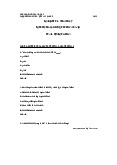


















Preview text:
thu.nguyenthianh@hoasen.edu.vn T: 0903709601
W1: Introduction & MKT/ Media Ecology
Marketing => Communication => Advertising => Media.
Marketing: Creating, Communicating, Delivering & Exchanging Value for customers,
clients, partners and society at large
Value: Customer’s perception of benefits of a product or service against the cost of acquiring and consuming it
Functional: giá trị lý tính
Experimental: giá trị trải nghiệm
Psychological: Địa vị Communication: Involves mass media
Message is transmitted to large groups of individuals What is media? (place)
WHERE consumers receive advertising messages about the products.
Media Selling is selling the opportunity that consumers can receive the message about the product.
W2: SYSTEM OF SELLING & TYPES OF SELLING
The AESKOPP System of Selling
+ Attitude: Thái độ vui vẻ, chào đón nhiệt tình
+ Emotional Intelligence: Khả năng thấu hiểu, hiểu bản thân và người khác What EQ you need? Personal competence
*Tự nhận thức (self awareness)
(Cảm nhận về cảm xúc/ Điểm mạnh, điểm yếu, giới hạn/ Giá trị và năng lực)
Emotional self awareness (gut senses)
Accurate self assessment (knowing your strengths and limits) Self-confidence
(sense of your worth and capacities)
*Tự quản lý (self management)
(Kiểm soát cảm xúc/ Minh bạch/ Khả năng thích ứng/ Ý thức về thành quả/ Chủ động / Lạc quan) Emotional self management Transparency Adaptability Achievement
Initiative - ready to act to seize the opportunity Optimism Social competence
*Nhận thức xã hội (social awareness)
(Đồng cảm với người khác/ Trách nhiệm với tổ chức/ Nhận biết nhu cầu của khách hàng) Sympathy
Organizational awareness (reading the situations, decisions networks and politics at the organizational level) Service Meeting client
*Quản lý mối quan hệ (relationship management)
(Truyền cảm hứng/ Đóng góp, phát triển cho người khác/ Dám nghĩ, dám làm/ Quản lý tốt
các mqh bên trong và bên ngoài/ Tinh thần hợp tác) Inspirational leadership Influence Developing others
Change catalyst - initiating, managing, and leading a new direction Conflict management Teamwork and collaboration
+ Skill: Kỹ năng bán hàng
*Influence & Creating Value *Prospecting
*Identifying problems, generating solutions *Proposal, presenting *Negotiating and closing
+ Knowledge: Kiến thức *Your medium:
*Mỗi nền tảng trong media được gọi là Medium.
*Mỗi kênh riêng trong medium được gọi là Vehicle
VD: MEDIUM IS TV => VEHICLE IS HTV2 *Data
*Marketing & Advertising market
*Consumer (người mua và sd sản phẩm) & Customer *Competitor
+ Opportunity: cơ hội
+ Preparation: Sự chuẩn bị
+ Persistence: Sự kiên trì *Never give up Types of Selling 2 Types of customers:
*Inexperienced generalist => needs help from salespeople, kiến thức chuyên trong ngành.
*Experienced specialist => bán ý tưởng và hiệu quả Functions of Salesperson 3 Key functions *Solve problem *Competitive advantage *Manage relationship 1. Solution Selling
• The ultimate customer-focuses, non-manipulative approach is the global trend.
• Help buyers invest in advertising that provides solutions to marketing and advertising
problems and that gets results.
2. Creating Competitive Advantages: willing to pay & difficult to find replacement.
• Differentiate your product and its features, benefits and advantages and makes it worth
more to your customers so that they will be willing to pay and difficult to find replacement.
• Added value to reinforce the value of advertising, of your medium, and of your product
so that reinforce the inherent assumption that expensive equals good. 3. Relationship management
Establishing relationships and keeping them. 3 important things:
> Do unto others as they would have others do unto them
> People like and trust people like themselves
> People don't care how much you know until they know how much you care
W3: SALES ETHICS, ATTITUDE
What are ethics? (Đạo đức là?)
Standards and norms of right & wrong that are expressed as guidelines for behaviors (Là
những tiêu chuẩn về đúng và sai cho con người.) 3 Ethics Standards + Code of conducts + Social and ethnic groups + Individuals Why ethics in media?
How do people drive their life?
Engine - knowledge, talent (kiến thức, tài năng) Energy - Effort (nghị lực)
Controller - Ethics (đạo đức)
Gravity (lực hấp dẫn): Nguyên tắc là một hiện tượng tự nhiên mà tất cả vật có khối lượng
hoặc năng lượng gồm các hành tinh, ngôi sao, thiên hà và thậm chí ánh sáng đều bị hút về nhau. 5Cs of ethical Responsibility
+ Responsibility to consumers: not accepting advertising for products/services that are unsafe/cheating.
+ Responsibility to their conscience: increase your self-esteem, self-image & self-confidence
+ Responsibility to customers:
+ Responsibility to the community: *An industry community *A local community
+ Responsibility to a company:
*Must be law abiding, respectful of civil liberties and actions or statements
*Must give their job their full attention, not steal company’s assets, not waste its resources,
not file false expense reports, and not offer special deals to get business away from others.
Nguyên tắc nội dung quảng cáo
+ Đảm bảo quảng cáo đúng luật định (lưu ý những sản phẩm gây nghiện, gây hại, sp người lớn,...)
+ Luận điệu trong quảng cáo phải chứng minh thỏa đáng
+ Không xúc phạm người dùng
+ Không sai lệch, dễ gây nhầm lẫn, lừa dối, không có spam.
Responsibility to our customers Dos
• Do represent your clients • Be fair to your clients
• Keep privileged information confidential • Under promise Don'ts
• Don't lie to advertisers
• Don't sell anything that customers don't truly need
• Don't use bait-and-switch tactics
• Don't recommend /accept ads that is in bad taste or harm client's image
• Don't accept false or misleading advertising • Don't give kickbacks
What attitudes are required for a successful media seller? Nice & Kind: 1. Honest, Positive
2. Cooperative being a good team member
3. Nurturing means caring for others Strong:
4. Committed, confident, competitive Creative:
5. Flexible - willing to change, open for new ideas.
W4: INFLUENCE & CREATING VALUE Pull - Influence *The Psychology of influence * Push - Creating value The Psychology of influence
Principles of influence: Dùng tâm lý để thuyết phục
1. Automatic responses: perception of a good deal is based on several things,
including inherent assumptions and contrast.
2. Reciprocation: we want to provide to others the kind of actions they have provided
to us.(người ta thường có xu hướng muốn làm gì đó khi mình nhận được một điều gì đó) (có qua có lại)
3. Commitment and consistency:
Some techniques to get people’s commitment:
Foot-in-the-door: to get people say yes to small things first, then the larger and
larger ones(chia nhỏ cơ hội)
Door-in-the-face: show the people big value first then offer the smaller ones or to
give people a bì picture to do smth while spending minimal amount (cái lợi trước mắt)
Amplify commitment: Achieve consistency by publishing people’s commitment.
4. Social proof: (dùng xã hội chứng minh)
Strong influence under two conditions:
+ when we view others to be similar to ourself
+ when people feel unfamiliar or insecure in a specific situation.
5. Scarcity: opportunities seem more valuable when they are less available (limited-number).
6. Liking and authority:
We prefer to say yes to people we know and like
Symbols that communicate authority: titles, clothes and trapping.
Why creating value?
+ Enhance your credibility and builds trust
+ Forestall and minimize future objections, esp. price objection
+ Reinforces your solutions-selling approach
+ Helps to avoid commodity selling
+ Control your customers’ expectation What is value? Value is a perception! Value in media Value signals
+ Company image & reputation + Ethical practices + Awards and prizes + Content + Price + Management + Production values + Sales presentation + Sales people + Idea for added value + Creative approaches
*Giá trị của medium: có nhiều khán giả 6 things in creating value
1. Reinforce your expertise as a problem solver
2. Reinforce the value of advertising
3. Reinforce the value of your medium ()
4. Reinforce the value of your product (service & solution)
5. Position the benefits & advantage of your product:
+ Features - information about the product + Advantages
6. Include a return-on-investment (ROI) analysis Approach Strategies:
+ Recognition of needs (to innovate)
+ Evaluation of options (to create value)
+ Resolution of concerns (to sell solutions) NOTES:
MKT Variables that Affect Sales: + Competitors’ offers
+ Competitors’ advertising activity + Competitors’
2 Don’t in creating value
+ Don’t promise result + Don’t knock the competiton
6 Steps of solution selling. PROSPECTING
1. Keep the prospect section full (Luôn làm đầy khách hàng tiềm năng)
2. Keep pending accounts hot and close them (Tăng cường tiếp cận để chốt hợp đồng)
3. Make active account raving fans (Biến khách hàng hiện hữu trở thành khách hàng tiềm năng)
4. Renewals “Advertisers don’t become customers until they renew” (Tài ký hợp đồng) Methods of prospecting
1. By current advertisers in other media
2. By season (theo từng mùa mà chúng ta bán media theo mùa đó vd: mùa worldcup
thì chúng ta có thể bán media cho những brand pv cho mùa worldcup) 3. By cate
4. By geographic region (mỗi vùng miền sẽ có những insight khác nhau,văn hoá khác nhau)
5. By advertisers in your medium 6. By inactive advertisers
7. By current advertisers (dùng khách hàng để recomment cho khách hàng mới)
8. By business, civic, or social organization(cách connect nhiều người với nhau bằng hội thảo, hội nhóm) Identifying problems
2 steps - qualifying & identifying the problems
*Qualifying - the step that you begin the relationship with your customers.
*Identify needs - both business and personal. Techniques:
*Use explore questions (i.e open-end, closed-end, verification,etc,...)
*After you get the answer, ask “why?” or “how?”,... Don’t ask leading question Generating solutions Presenting Negotiating and closing Servicing
Writing a client brief helps you create an outline of your needs and goals when planning your
task around a project. It is a crucial document that is written prior to the
commencement of a project to convey project goals to an agency or organization you have
decided to work with. Let us explore client briefs in detail. What is a Client Brief?
A document that guiding a project written by Client. It helps manage expectations and keep
both parties grounded with what was agreed upon before starting the project. A Perfect Client Brief
Client must be clear about their objectives and goals and the brief should have these following steps: + Describe the brand + The target market
+ What business problem (overview of the challenges and objectives)
+ Analyze the competitive landscape
+ Define the end-result the expect
+ Outlines the scope and aspirations of the project + Offer a brief distribution + Budget 1. The brand/ the product -
Client’s brand (what do they do, their core operations, how long have they been in business)
• The information in this session should be included: - Brand values
- Brand characters/ brand personality - Brand hierarchy - etc...
→ To make sure they articulate all this information correctly to help out the agency working on the project. 2. Project Overview
- challenges, objectives and expected results
The information in this section should be included:
• Company goals, their mission, vision, and story behind the brand helps the creatives
analyze their business and create suitable strategies. • Company business plan
• Company/ product's strengths, competitive advantages • Brand Positioning
• Projections for future income and costs 3. Target Audience
• Geographic, demographic, psychologic. • Question to ask:
Why are people buying the product? Who is decision making?
How they know about the product? (media usage habits)
How they buy the product? (buying process) How they use the product? 4. Competitors 5. Cost/ budget
• Discuss the budget allocated for the project. • A specific budget. • Otherwise, we need:
• Client's cost structure (how much does it cost them to make a product? how much
profit will be made from each extra sales? (sales margin)
• Their revenue, annual budgets and goals?
• From there, we can understand how much they ought to spend on communication
Rules for Brainstorm 1. Everyone must contribute
2. Let your imagination run wild (in best situatuion & expand)
3. Do not be judgmental at the beginning + Push extremes + Look for opposites
+ Use free-form word associations + Go off on tangents 4. Look for combinations 5. Make connections 6. Modify 7. Write everything down 8. Select the best idea
How to brief your media department
+ Good idea planning usually means: allowing media buyers to respond to buying
opportunities as they crop up, while it must satisfy the creative/ communication message.
+ You’ll probably thrash out some of the major media issues with your media planner
and someone from the creative department
+ Best result from media department comes from your proper brief. Media Brief should include: 1. Product objectives 2. Advertising objectives 3. The competition 4. Media objectives 5. Budget 6. Target audience 7. Regionality 8. Seasonality 9. Campaign timing 10. Creative considerations.



